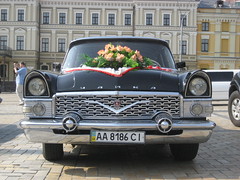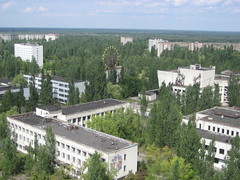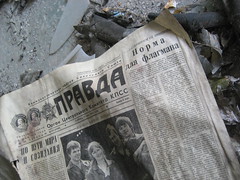The Ghosts of Chernobyl
After my bizarre trip through the wallet-lightening border of Transdniestria, I ended up safely across into Ukraine and landed in the chaotic Kiev train station. Randomly, in the midst of the hustle and bustle, I ran right into my British friend Will, who I had traveled with a few weeks earlier in Bulgaria. I dropped off my stuff at his hotel in central Kiev, then headed out with him into the city.
I'm not sure what I was expecting out of Kiev, but I was surprised to find a bright and vibrant city full of historic churches, busy pedestrian areas, shady tree-lined streets, and restaurants galore. It was definitely a world away from the gray soviet-era mess I had left back Moldova. Will and I checked out the plaza where the 2004 Orange Revolution took place, scoped out some of the city's oldest cathedrals, bought a few old soviet souvenirs on the cobblestone Andreevsky Spusk, and dodged tons of wedding parties in Kiev's numerous public plazas which were swarming with photographers, happy couples in typical wedding attire, and old cars dressed up for the occasion.

Will and I also stopped by the fairly interesting Chernobyl museum, which thoroughly documented the infamous nuclear disaster, which took place in northern Ukraine back in the days of the USSR before the fall of communism. The museum was well done, but the following day, I went to somewhere much more interesting: the real thing.
Since about 2004, tourists have been able to go to the Chernobyl disaster area led by a guide from a few government-registered tour companies. Digging around online as I prepared for this trip, I read several passionately-written articles by journalists who had visited Chernobyl and the experience sounded too amazing to miss. These days, over twenty years since the disaster, the once-lethal radiation levels at Chernobyl have dramatically decreased, and are now fairly low — about the same as those found in any major city. There are still hot-spots and restricted areas, but much of the disaster area is now safe to visit. Following in the footsteps of journalists and increasing numbers of adventurous tourists, I signed up for a day trip to see it for myself.
Our group met up at a hotel in Kiev, then piled into a bus for a trip about three hours north toward the border with Belarus. The radioactive site is protected by two exclusion zones, where people have not been allowed to live since the reactor blew. Strangely enough, the area has become an unintentional wildlife refuge, home to a large population of wild boars armed with scimitar-like tusks and a surly disposition. Amazingly, some former-residents, mostly the very elderly, have been allowed to return to the exclusion zones and live in their old homes, just so long as they request no help or money from the government should they get ill.
As we passed through the outer exclusion zone, a few military policemen boarded the bus and checked our passports against the list of the day's official visitors. We continued along through a few more checkpoints and entered Chernobyl town, which is now home to more than 3800 international scientists and researchers studying the effects of the disaster. We were briefed a bit on what to expect, then headed off about ten miles north toward the site of the power plant complex itself. At the time of the explosion in 1986, there were four nuclear reactors running and two more being built. Incredibly, more than twenty years later, the unfinished Reactor #5 still sits frozen in mid-construction, surrounded by soaring cranes that will never complete their task.

A few miles down the road is the infamous Chernobyl Reactor #4, the center point of the disaster. The cause of the accident is hard to describe, and my art school brain had a hard time understanding the science of it all. What is clear is that the government of then-USSR was incredibly negligent and ultimately caused the disaster three ways: by allowing a nuclear plant to become poorly maintained, by allowing poor communication between staff on different shifts, and by allowing inexperienced workers trained for coal power plants to handle Chernobyl's night shift. On April 26th, 1986, these three forces created a perfect storm, and the world's largest nuclear disaster was born, with radioactive fallout estimated at more than 100 times that of the Hiroshima atomic bomb. So what did the USSR government do? They tried to cover it up.
But first, they had to stop all the fires from burning and get the reactor into a stable condition, a responsibility pushed onto a lot of young men who had no idea what they were signing up for. Apparently, for every five minutes served fighting the Chernobyl fires, the government offered men two years off from their compulsory military service. At the Chernobyl museum in Kiev, there is shocking video footage of these guys smiling and laughing as they go in to fight the radioactive blaze, giddy about not having to serve in the military. Little did they know, the government was also guaranteeing them a death sentence, and indeed, these men were the first to die from cancer and radiation poisoning just days after the disaster. Even after people started to die, the USSR seemed to have no plans to reveal the disaster to the world. In fact, it was initially discovered because the wind carried radioactive particles all the way to a Swedish power station, where workers frantically searched for a leak before realizing that the radiation wasn't coming from their plant. The news hit international papers, and Russia was forced to come clean. The official line of the government is that some 60 people died immediately, and around 4000 more from radiation-caused cancer. Given the extent to which Moscow tried to cover up the accident, the real numbers are surely much higher than that.
Today, there are still areas near the reactor which are extremely unsafe, depending on which direction the wind was blowing the radiation the day of the explosion. Even the area we went had relatively high levels of radiation — safe for short-term exposure measuring into the minutes, but not the kind of place you'd want to set up a tent and hang out. It was surreal to see Reactor #4 up so close, now covered in its famous concrete sarcophagus. Our professional guide assured that the levels of radioactivity were safe, but I definitely got comfort in seeing the groups of international scientists walking around the site in plain clothes. Here's a close-up of Reactor #4:

The most interesting part of the tour wasn't the reactor itself, but rather the nearby town of Priypat, where some 52,000 people lived. The city was built for Chernobyl employees and scientists as a soviet utopia, where the social and intellectual elite could live the high life. Supposedly, the residents of Priypat even had access to luxury goods like Chanel perfume from France. A full day after the explosion — on my third birthday, April 27th, 1986 — the soviets finally decided to evacuate the town, located only about a five minute walk from the radiation-gushing Chernobyl power plant. The evacuation was massive: the more than fifty-thousand people living in Priypat were loaded onto some 1100 buses brought in from all over the USSR to get the people out of there. Residents were told that they would need to leave for up to three days — they were never allowed to return.
Now, Priypat stands as a surreal soviet ghost town. And although in the twenty years since the Chernobyl disaster the town has been trashed and gutted by looters and slowly broken down by the slow grind of natural erosion, Priypat is still a haunting and fascinating look into a dark day in the history of man. We started with a tour through the Ministry of Culture, the heart of Priypat's cultural activities. The blocky grand foyer was mostly in ruins, but the soviet mural painting lingered as a relic from happier times.

The cultural center also housed a huge community theater, a series of smaller meeting rooms, locker rooms, a swimming pool, and a mid-sized gymnasium. In the gym, a few remnants of life shined out through the mess — a poster of a Russian boxer, a bulletin board with long-faded messages, and a few old gym shoes.

We ventured outside the cultural complex to an area where an amusement park once stood. With all the talk of evacuation plans, government negligence, and radiation levels, it's easy to forget that Priypat was a town just like any other, full of ordinary people. For me, seeing the frozen and rusted amusement park really drove home the human element of the disaster. A massive ferris wheel creaked as its joints ground in the wind. Wooden planks on the benches of a tilt-a-whirl are looked ready to succumb to nature. Rusty bumper cars sat scattered as if the power would come back on at any second and restart the once-happy scene.


From the amusement park, we entered one of the old blocky apartment buildings and climbed all the way to the top for a view out over the massive planned city. Along the way, we climbed through a few of the old apartments, where there are still beds, tattered wallpaper, and other items left behind by the evacuees. In one apartment, I saw cartoon stickers on the window and couldn't help but shudder knowing that the little kid who stuck them there probably sat in that room not knowing that invisible, deadly radiation filled the apartment's air for more than 24 hours before the town was evacuated.
Our last stop, and definitely the most horrifying, was Priypat's former school, where hundreds of desks and books were strewn about a cluster of classrooms. Soviet newspapers from the days leading up to the disaster are mixed into the mess, and in some places chalk was still barely visible on chalkboards. A music classroom had black-stemmed notes pasted onto the wall and broken vinyl records on the floor. In the kindergarten and nursery, dolls, toy instruments, and stuffed animals shared the floor with gas masks distributed during the disaster.



After our tour of the disaster area was complete, our group went through bizarre radiation-testing machines, then headed back to Kiev. Visiting Chernobyl was an unbelievably memorable and truly moving experience. Seeing a completely abandoned city with so many traces of people was bizarre, and caused a disconnect in my brain. It's easy to visit old ruined towns like Pompeii in Italy or Ephesus in Turkey and try to imagine how these cities must have been, but seeing a thoroughly modern city in ruins was a completely different feeling. In the nursery and kindergarten area, I couldn't help but try to put myself in those kids shoes. Because of the neglegence of a group of overzealous adults, kids my own age were invisibly invaded by cancer-causing radioactivity, giving them life-long illnesses with which they will forever have to cope. It was such an insane feeling, and not one I'll soon forget.
Here are a few more shots from around the sorrowful town of Priypat:



I'm writing this from London, where I arrived today on a flight from Sofia, Bulgaria. There's a lot of my trip left to write about, including my excellent adventures in Croatia, Bosnia, Montenegro, and Albania with Gerni. Plus, my solo jaunt through Macedonia and the headline-grabbing region of Kosovo. But I'll have to save those stories for when I get home, so this will be my last blog entry while I'm on the road. Thank you all so much for reading along this whole time — it has really meant a lot to me!
In three days, I'm catching a flight across the Atlantic back to the good ol' United States of America, where I haven't been for more than a year. I'll spend just short of a week in New York with my old work friends, Steve, Jorge, and Charles. Then, I'll stop by Providence to see my old pal Austin, then to Boston where I'll fly on September 15th back home to COLORADO! I can't even tell you how exciting it is to type that. I'm almost home!
See you soon,
Ryan!
2 Comments:
Ryan!,
It's been really eye opening to read about your experience at Chernobyl, and the photos are really incredible, as always. Kind of spooky.
Safe travels to you as you head HOME!!!
Crazy man, that's some wacky stuff. Those Russians really screwed the pooch on that one.
Glad to hear you're going home, though i've gotten no email or phone confirmation that you've actually done so. what gives? you too good to call a mexican now?
dat's wacist.
Post a Comment
<< Home